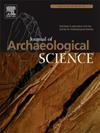在生物考古背景下探索与应激源暴露风险相关的死亡率差异的生成模型
IF 2.5
1区 地球科学
Q1 ANTHROPOLOGY
引用次数: 0
摘要
在生物考古学中,生成模型是一种未充分利用的工具,它可以直接询问死亡年龄是如何受到暴露于压力源的各种风险的影响,同时考虑到生物考古学家通常看不见的因素。此外,在生物考古学中常见的各种样本量的人群中可疑差异的可见性也可以进行检查,有助于为解释发现提供信息。在本研究中,生成了50、100、500和1000个0岁个体的队列。每个人都被分配了一个脆弱值,并分为高风险组和低风险组。这些队列是通过模拟模型运行的,在模拟模型中,压力源的暴露根据风险组和暴露的压力源的严重程度而变化。每组高、低风险组的平均死亡年龄差异采用Welch t检验进行显著性检验。模型结果用于确定生物考古研究的潜在最小样本量,在这种情况下,由于压力源暴露的差异,死亡年龄的真正差异可能是可见的。小队列(50个人)在死亡年龄上发现真正风险组差异的可能性很低,除非压力源暴露或压力源严重程度的差异足以产生20年的平均寿命差异。当所有队列中压力源暴露和/或压力源严重程度的差异增加时,观察到风险组之间真正的死亡年龄差异的可能性增加。因此,除非压力或不平等程度很高,否则在小型考古样本中可能无法识别群体寿命水平的差异。小样本结果的低可靠性重申了在生物考古研究中仔细检查均衡性的必要性,正如将该模型应用于研究迪克森土丘晚期林地阶段的案例研究所证明的那样。本应用评估了Goodman和Armelagos(1988)提出的三个潜在假设,以确定当样本量不是种群内潜在差异可见性的限制因素时,它们的可能性有多大。本文章由计算机程序翻译,如有差异,请以英文原文为准。
A generative model for exploring differences in mortality associated with stressor exposure risk in bioarchaeological contexts
Generative models are an underutilized tool in bioarchaeology that make it possible to directly interrogate how age-at-death is influenced by varied risk of exposure to stressors, while accounting for factors which are ordinarily invisible to bioarchaeologists. Further, the visibility of suspected differences within populations at the sorts of sample sizes common to bioarchaeology can also be examined, helping to inform interpretation of findings.
In the present study, cohorts of 50, 100, 500, and 1000 individuals aged 0 years were generated. Each individual was assigned a frailty value, and to either high or low risk groups. These cohorts were run through simulation models in which exposure to stressors varied according to risk group and the severity of stressors if exposed. The difference in mean age-at-death between high and low risk group for each run was tested for significance using Welch's t-test. The model results are used to identify potential minimum sample sizes for bioarcheological research at which true differences in age-at-death due to difference in stressor exposure are likely to be visible.
Small cohorts (50 individuals) had low likelihood of detecting true risk group differences in age-at-death except when the difference in exposure to stressors or the severity of the stressor was great enough to produce a mean difference in lifespan of >20 years. The probability of observing a true difference in age-at-death between risk groups increased when the difference in stressor exposure and/or the stressor severity increased for all cohorts. Therefore, group-level differences in lifespan may not be identifiable in small archaeological samples except where stress or inequality is high. The low reliability of results from small samples reiterates the needs to carefully examine equifinality in bioarcheological research, as demonstrated through the application of this model to a case study which examined the Late Woodland phase of the Dickson Mounds. This application assessed the three potential hypotheses put forth by Goodman and Armelagos (1988) to establish how likely they may be when sample size is not a limiting factor on visibility of potential difference within populations.
求助全文
通过发布文献求助,成功后即可免费获取论文全文。
去求助
来源期刊

Journal of Archaeological Science
地学-地球科学综合
CiteScore
6.10
自引率
7.10%
发文量
112
审稿时长
49 days
期刊介绍:
The Journal of Archaeological Science is aimed at archaeologists and scientists with particular interests in advancing the development and application of scientific techniques and methodologies to all areas of archaeology. This established monthly journal publishes focus articles, original research papers and major review articles, of wide archaeological significance. The journal provides an international forum for archaeologists and scientists from widely different scientific backgrounds who share a common interest in developing and applying scientific methods to inform major debates through improving the quality and reliability of scientific information derived from archaeological research.
 求助内容:
求助内容: 应助结果提醒方式:
应助结果提醒方式:


